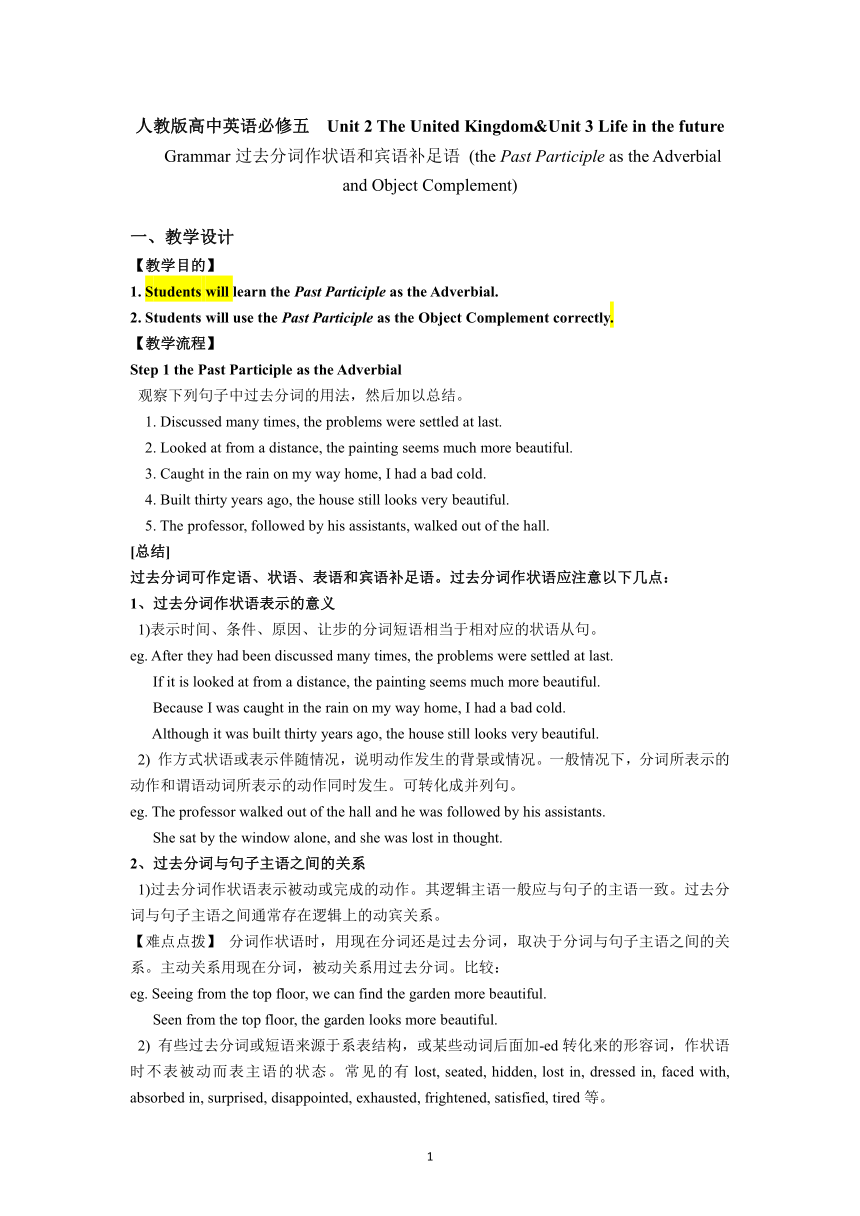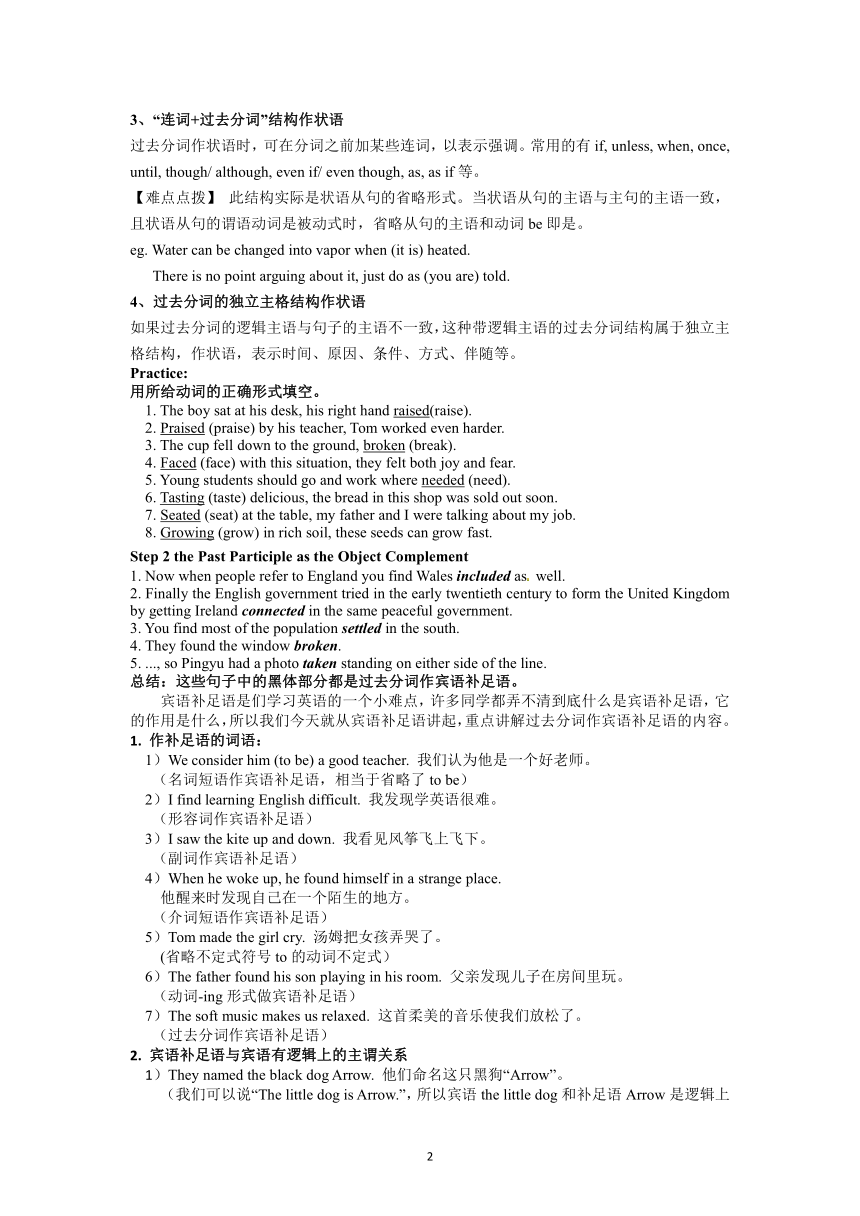人教版(新课程标准)必修5Unit 2 The United Kingdom 过去分词作状语和宾补教案
文档属性
| 名称 | 人教版(新课程标准)必修5Unit 2 The United Kingdom 过去分词作状语和宾补教案 |

|
|
| 格式 | zip | ||
| 文件大小 | 43.0KB | ||
| 资源类型 | 教案 | ||
| 版本资源 | 人教版(新课程标准) | ||
| 科目 | 英语 | ||
| 更新时间 | 2021-11-13 18:20:20 | ||
图片预览


文档简介
人教版高中英语必修五 Unit 2 The United Kingdom&Unit 3 Life in the future
Grammar过去分词作状语和宾语补足语 (the Past Participle as the Adverbial and Object Complement)
一、教学设计
【教学目的】
1. Students will learn the Past Participle as the Adverbial.
2. Students will use the Past Participle as the Object Complement correctly.
【教学流程】
Step 1 the Past Participle as the Adverbial
观察下列句子中过去分词的用法,然后加以总结。
1. Discussed many times, the problems were settled at last.
2. Looked at from a distance, the painting seems much more beautiful.
3. Caught in the rain on my way home, I had a bad cold.
4. Built thirty years ago, the house still looks very beautiful.
5. The professor, followed by his assistants, walked out of the hall.
[总结]
过去分词可作定语、状语、表语和宾语补足语。过去分词作状语应注意以下几点:
1、过去分词作状语表示的意义
1)表示时间、条件、原因、让步的分词短语相当于相对应的状语从句。
eg. After they had been discussed many times, the problems were settled at last.
If it is looked at from a distance, the painting seems much more beautiful.
Because I was caught in the rain on my way home, I had a bad cold.
Although it was built thirty years ago, the house still looks very beautiful.
2) 作方式状语或表示伴随情况,说明动作发生的背景或情况。一般情况下,分词所表示的动作和谓语动词所表示的动作同时发生。可转化成并列句。
eg. The professor walked out of the hall and he was followed by his assistants.
She sat by the window alone, and she was lost in thought.
2、过去分词与句子主语之间的关系
1)过去分词作状语表示被动或完成的动作。其逻辑主语一般应与句子的主语一致。过去分词与句子主语之间通常存在逻辑上的动宾关系。
【难点点拨】 分词作状语时,用现在分词还是过去分词,取决于分词与句子主语之间的关系。主动关系用现在分词,被动关系用过去分词。比较:
eg. Seeing from the top floor, we can find the garden more beautiful.
Seen from the top floor, the garden looks more beautiful.
2) 有些过去分词或短语来源于系表结构,或某些动词后面加-ed转化来的形容词,作状语时不表被动而表主语的状态。常见的有lost, seated, hidden, lost in, dressed in, faced with, absorbed in, surprised, disappointed, exhausted, frightened, satisfied, tired等。
3、“连词+过去分词”结构作状语
过去分词作状语时,可在分词之前加某些连词,以表示强调。常用的有if, unless, when, once, until, though/ although, even if/ even though, as, as if等。
【难点点拨】 此结构实际是状语从句的省略形式。当状语从句的主语与主句的主语一致,且状语从句的谓语动词是被动式时,省略从句的主语和动词be即是。
eg. Water can be changed into vapor when (it is) heated.
There is no point arguing about it, just do as (you are) told.
4、过去分词的独立主格结构作状语
如果过去分词的逻辑主语与句子的主语不一致,这种带逻辑主语的过去分词结构属于独立主格结构,作状语,表示时间、原因、条件、方式、伴随等。
Practice:
用所给动词的正确形式填空。
1. The boy sat at his desk, his right hand raised(raise).
2. Praised (praise) by his teacher, Tom worked even harder.
3. The cup fell down to the ground, broken (break).
4. Faced (face) with this situation, they felt both joy and fear.
5. Young students should go and work where needed (need).
6. Tasting (taste) delicious, the bread in this shop was sold out soon.
7. Seated (seat) at the table, my father and I were talking about my job.
8. Growing (grow) in rich soil, these seeds can grow fast.
Step 2 the Past Participle as the Object Complement
1. Now when people refer to England you find Wales included as well.
2. Finally the English government tried in the early twentieth century to form the United Kingdom by getting Ireland connected in the same peaceful government.[]
3. You find most of the population settled in the south.
4. They found the window broken.
5. ..., so Pingyu had a photo taken standing on either side of the line.
总结:这些句子中的黑体部分都是过去分词作宾语补足语。
宾语补足语是们学习英语的一个小难点,许多同学都弄不清到底什么是宾语补足语,它的作用是什么,所以我们今天就从宾语补足语讲起,重点讲解过去分词作宾语补足语的内容。
1. 作补足语的词语:
1)We consider him (to be) a good teacher. 我们认为他是一个好老师。
(名词短语作宾语补足语,相当于省略了to be)
2)I find learning English difficult. 我发现学英语很难。
(形容词作宾语补足语)
3)I saw the kite up and down. 我看见风筝飞上飞下。
(副词作宾语补足语)
4)When he woke up, he found himself in a strange place.
他醒来时发现自己在一个陌生的地方。
(介词短语作宾语补足语)
5)Tom made the girl cry. 汤姆把女孩弄哭了。
(省略不定式符号to的动词不定式)
6)The father found his son playing in his room. 父亲发现儿子在房间里玩。
(动词-ing形式做宾语补足语)
7)The soft music makes us relaxed. 这首柔美的音乐使我们放松了。
(过去分词作宾语补足语)
2. 宾语补足语与宾语有逻辑上的主谓关系
1)They named the black dog Arrow. 他们命名这只黑狗“Arrow”。
(我们可以说“The little dog is Arrow.”,所以宾语the little dog和补足语Arrow是逻辑上的主谓关系。)
2)I noticed a little girl drawing under the tree. 我注意到一个小女孩在树下画画。
(小女孩在画画,即宾语补足语的动作是女孩做的,宾语与补足语是逻辑上的主谓关系,而且是主动的,用动词-ing形式作宾语补足语)
3)We should keep him informed of what is going on here.
我们必须让他了解这里发生的事。
(他被告知某事,说明宾语“他”与补足语“告知”是被动的主谓关系,也称为“动宾关系,即动词及其宾语的关系”,用过去分词作宾语补足语)
3. 介词的宾语补足语
有些介词的宾语有时也需有补足语,构成介词宾语的复合结构。
eg. We were all excited, with the bonfire burning late into the night.
篝火一直烧到深夜,我们都很兴奋。(burning作介词with的宾语the bonfire的补足语)
Practice:
用动词的正确形式填空:
1. Have you got a map to show me I’m puzzled. (puzzle).
2. Did he have his wallet stolen (steal) last Friday?
3. When I got to the supermarket, I found it closed (close).
4. He found his wife cooking (cook) in the kitchen when he woke up at five.
5. He watched the bed carried (carry) out of the room.
6. She doesn’t want her daughter to be taken (take) out after dark.
7. When will you have your eyes examined (examine)
8. My mother got me to check (check) all the homework I did last night.
9. With the boy leading ( lead) the way,we will find the house easily tomorrow.
10. I can hear the windows being beaten (beat) by the heavy rain.
Step 3 Summary
The structure of the period is:
Step 4 Homework
二、相关教学资源
教师用书http:///ge/jszx/jtj/dzkb_1/B2/201107/t20110714_1056212.htm ( http: / / / ge / jszx / jtj / dzkb_1 / B2 / 201107 / t20110714_1056212.htm )
过去分词作状语和宾语补足语(the Past Participle as the adverbial and object complement)
过去分词作状语(the Past Participle as the Adverbial)
过去分词作宾补(the Past Participle as the Object Complement)
Grammar过去分词作状语和宾语补足语 (the Past Participle as the Adverbial and Object Complement)
一、教学设计
【教学目的】
1. Students will learn the Past Participle as the Adverbial.
2. Students will use the Past Participle as the Object Complement correctly.
【教学流程】
Step 1 the Past Participle as the Adverbial
观察下列句子中过去分词的用法,然后加以总结。
1. Discussed many times, the problems were settled at last.
2. Looked at from a distance, the painting seems much more beautiful.
3. Caught in the rain on my way home, I had a bad cold.
4. Built thirty years ago, the house still looks very beautiful.
5. The professor, followed by his assistants, walked out of the hall.
[总结]
过去分词可作定语、状语、表语和宾语补足语。过去分词作状语应注意以下几点:
1、过去分词作状语表示的意义
1)表示时间、条件、原因、让步的分词短语相当于相对应的状语从句。
eg. After they had been discussed many times, the problems were settled at last.
If it is looked at from a distance, the painting seems much more beautiful.
Because I was caught in the rain on my way home, I had a bad cold.
Although it was built thirty years ago, the house still looks very beautiful.
2) 作方式状语或表示伴随情况,说明动作发生的背景或情况。一般情况下,分词所表示的动作和谓语动词所表示的动作同时发生。可转化成并列句。
eg. The professor walked out of the hall and he was followed by his assistants.
She sat by the window alone, and she was lost in thought.
2、过去分词与句子主语之间的关系
1)过去分词作状语表示被动或完成的动作。其逻辑主语一般应与句子的主语一致。过去分词与句子主语之间通常存在逻辑上的动宾关系。
【难点点拨】 分词作状语时,用现在分词还是过去分词,取决于分词与句子主语之间的关系。主动关系用现在分词,被动关系用过去分词。比较:
eg. Seeing from the top floor, we can find the garden more beautiful.
Seen from the top floor, the garden looks more beautiful.
2) 有些过去分词或短语来源于系表结构,或某些动词后面加-ed转化来的形容词,作状语时不表被动而表主语的状态。常见的有lost, seated, hidden, lost in, dressed in, faced with, absorbed in, surprised, disappointed, exhausted, frightened, satisfied, tired等。
3、“连词+过去分词”结构作状语
过去分词作状语时,可在分词之前加某些连词,以表示强调。常用的有if, unless, when, once, until, though/ although, even if/ even though, as, as if等。
【难点点拨】 此结构实际是状语从句的省略形式。当状语从句的主语与主句的主语一致,且状语从句的谓语动词是被动式时,省略从句的主语和动词be即是。
eg. Water can be changed into vapor when (it is) heated.
There is no point arguing about it, just do as (you are) told.
4、过去分词的独立主格结构作状语
如果过去分词的逻辑主语与句子的主语不一致,这种带逻辑主语的过去分词结构属于独立主格结构,作状语,表示时间、原因、条件、方式、伴随等。
Practice:
用所给动词的正确形式填空。
1. The boy sat at his desk, his right hand raised(raise).
2. Praised (praise) by his teacher, Tom worked even harder.
3. The cup fell down to the ground, broken (break).
4. Faced (face) with this situation, they felt both joy and fear.
5. Young students should go and work where needed (need).
6. Tasting (taste) delicious, the bread in this shop was sold out soon.
7. Seated (seat) at the table, my father and I were talking about my job.
8. Growing (grow) in rich soil, these seeds can grow fast.
Step 2 the Past Participle as the Object Complement
1. Now when people refer to England you find Wales included as well.
2. Finally the English government tried in the early twentieth century to form the United Kingdom by getting Ireland connected in the same peaceful government.[]
3. You find most of the population settled in the south.
4. They found the window broken.
5. ..., so Pingyu had a photo taken standing on either side of the line.
总结:这些句子中的黑体部分都是过去分词作宾语补足语。
宾语补足语是们学习英语的一个小难点,许多同学都弄不清到底什么是宾语补足语,它的作用是什么,所以我们今天就从宾语补足语讲起,重点讲解过去分词作宾语补足语的内容。
1. 作补足语的词语:
1)We consider him (to be) a good teacher. 我们认为他是一个好老师。
(名词短语作宾语补足语,相当于省略了to be)
2)I find learning English difficult. 我发现学英语很难。
(形容词作宾语补足语)
3)I saw the kite up and down. 我看见风筝飞上飞下。
(副词作宾语补足语)
4)When he woke up, he found himself in a strange place.
他醒来时发现自己在一个陌生的地方。
(介词短语作宾语补足语)
5)Tom made the girl cry. 汤姆把女孩弄哭了。
(省略不定式符号to的动词不定式)
6)The father found his son playing in his room. 父亲发现儿子在房间里玩。
(动词-ing形式做宾语补足语)
7)The soft music makes us relaxed. 这首柔美的音乐使我们放松了。
(过去分词作宾语补足语)
2. 宾语补足语与宾语有逻辑上的主谓关系
1)They named the black dog Arrow. 他们命名这只黑狗“Arrow”。
(我们可以说“The little dog is Arrow.”,所以宾语the little dog和补足语Arrow是逻辑上的主谓关系。)
2)I noticed a little girl drawing under the tree. 我注意到一个小女孩在树下画画。
(小女孩在画画,即宾语补足语的动作是女孩做的,宾语与补足语是逻辑上的主谓关系,而且是主动的,用动词-ing形式作宾语补足语)
3)We should keep him informed of what is going on here.
我们必须让他了解这里发生的事。
(他被告知某事,说明宾语“他”与补足语“告知”是被动的主谓关系,也称为“动宾关系,即动词及其宾语的关系”,用过去分词作宾语补足语)
3. 介词的宾语补足语
有些介词的宾语有时也需有补足语,构成介词宾语的复合结构。
eg. We were all excited, with the bonfire burning late into the night.
篝火一直烧到深夜,我们都很兴奋。(burning作介词with的宾语the bonfire的补足语)
Practice:
用动词的正确形式填空:
1. Have you got a map to show me I’m puzzled. (puzzle).
2. Did he have his wallet stolen (steal) last Friday?
3. When I got to the supermarket, I found it closed (close).
4. He found his wife cooking (cook) in the kitchen when he woke up at five.
5. He watched the bed carried (carry) out of the room.
6. She doesn’t want her daughter to be taken (take) out after dark.
7. When will you have your eyes examined (examine)
8. My mother got me to check (check) all the homework I did last night.
9. With the boy leading ( lead) the way,we will find the house easily tomorrow.
10. I can hear the windows being beaten (beat) by the heavy rain.
Step 3 Summary
The structure of the period is:
Step 4 Homework
二、相关教学资源
教师用书http:///ge/jszx/jtj/dzkb_1/B2/201107/t20110714_1056212.htm ( http: / / / ge / jszx / jtj / dzkb_1 / B2 / 201107 / t20110714_1056212.htm )
过去分词作状语和宾语补足语(the Past Participle as the adverbial and object complement)
过去分词作状语(the Past Participle as the Adverbial)
过去分词作宾补(the Past Participle as the Object Complement)
